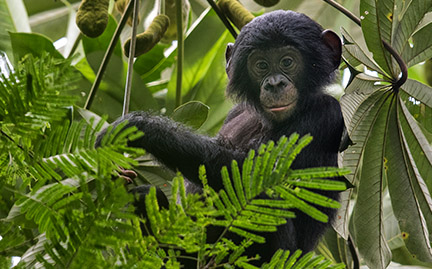Make Love, Not War

These bonobos are as interested and curious about you as you are about them.
The Pan paniscus, or commonly known as the bonobos, is generally known to be a peaceful animal species compared to their barbaric Chimpanzee cousins.
What’s their secret?
They make love, not war. Literally.
The bonobos are famed for its high level of sexual behavior and promiscuity and do not discriminate in their sexual behavior regardless of gender or age. Sex plays such a major role in bonobo societies that they use sex for social bonding and to resolve conflicts.
Bonobo societies are perceived to be matriarchal. The females, regardless of whether they are fertile, sterile or too young to reproduce, engage in mutual genital behaviour (genital-genital rubbing) to socially bond with each other to form “sisterhood hierarchies”. This enables them to dominate most of the males and control the best patches of food. Male bonobos may be individually stronger than a female, but they cannot stand alone against a united group of females should they be unlucky enough to incur their wrath.
Afterall, hell has no fury like a woman’s wrath, let alone a group of them.
It is also observed that adolescent females tend to leave their native community to join another. They engage in sexual bonding with other females in another community to establish themselves in the new community. Such migration encourages genetic diversity as this mixes the bonobo gene pools. It is also recorded that the mothers and their adult sons abstain from sexual intercourse to possibly avoid inbreeding.
When there is competition over food, Bonobos of different groups at a same feeding ground often engage in communal sexual activity to decrease tension and encourage peaceful feeding. Male bonobos also resolve conflicts arising from mating rights by engaging in mutual genital interaction (rubbing their scrotal sacs together while standing back to back) to express reconciliation with their rivals.
This is beneficial as it solidifies social dominance by maintaining strong social bonds. This reduces the probability of future aggression and thus, the energy necessary to defend against those attacks.
If you are interested to find out more or see the bonobos in action, feel free to search the net! Or you could just watch the video embedded below.
Do note that the video is rather not safe for work.
If you have kids watching this video, you may need to explain “The birds and the bees” to them.
Wild Wives of Africa : Bonobo Love
References
- Primate Factsheets: Bonobo (Pan paniscus) Behavior by Cawthon Lang KA 1 December 2010. <http://pin.primate.wisc.edu/factsheets/entry/bonobo/behav>. Accessed 28 Mar 2013.
- BONOBO SEX AND SOCIETY by: de Waal, Frans B.M., Scientific American, 00368733, Mar 1995, Vol. 272, Issue 3
- Nonconceptive Sexual Behaviour in Bonobos and Capuchins by Manson, Joseph H., Perry, Susan, Parish, Amy R., International Journal of Primatology, October 1997, Vol. 18 Issue 5: pp 767 – 786
- “Social Structure” by Laird, Courtney <URL: http://web.archive.org/web/20110519005633/http://www.bio.davidson.edu/people/vecase/Behavior/Spring2004/laird/Social%20Organization.htm>. Accessed on 28 Mar 2013
- “Wild Wives of Africa : Bonobo Love” by NatGeoWild. NatGeoWild YouTube Channel, 1 Nov 2011.
<URL: http://www.youtube.com/watch?v=82GUjPConiE>. Accessed on 28 Mar 2013. - “Bonobo picture” by World Wildlife Fund.
<URL: http://www.youtube.com/user/BBCEarth#p/a/u/1/wkJLHnYy_G0>. Accessed on 28 Mar 2013.